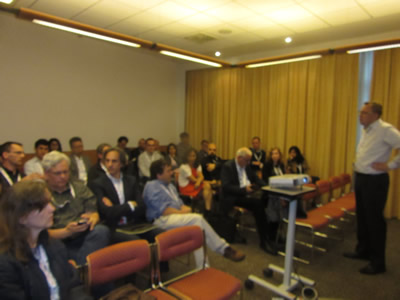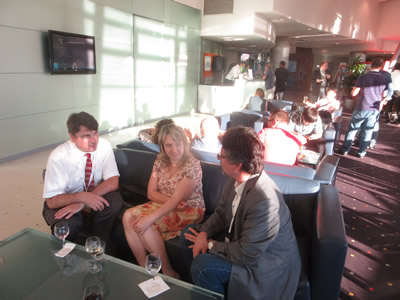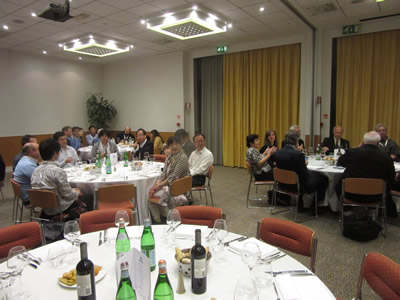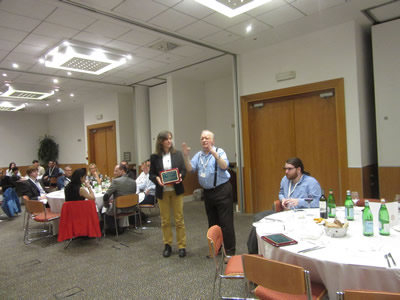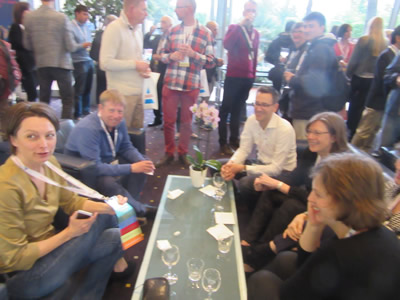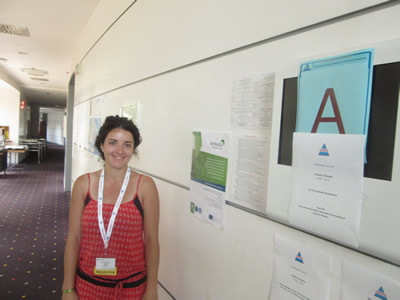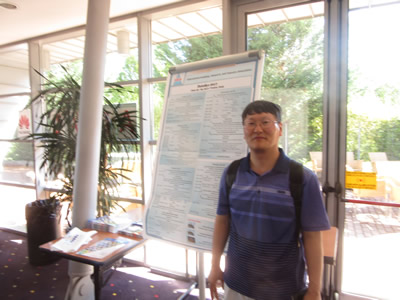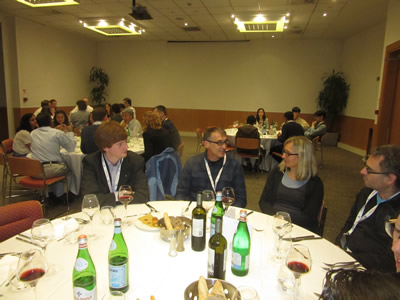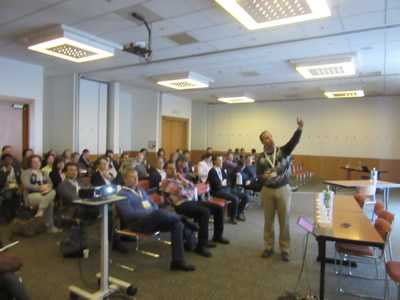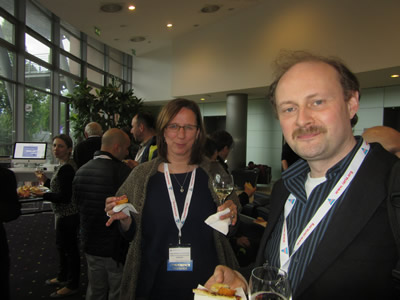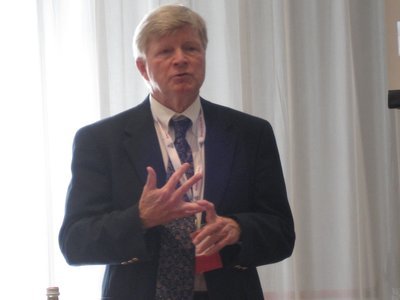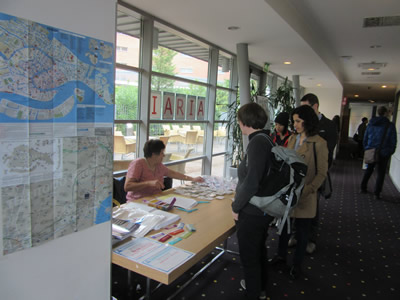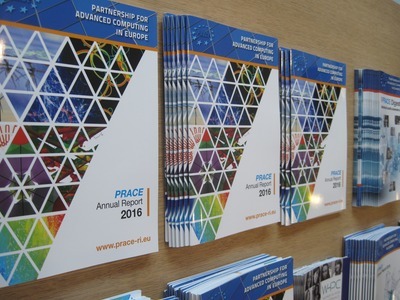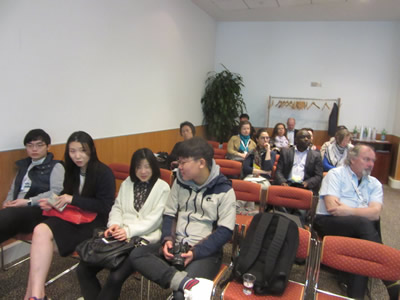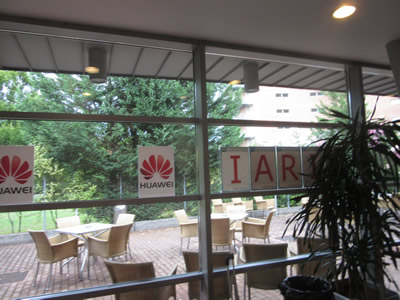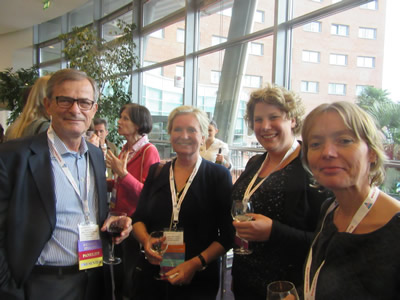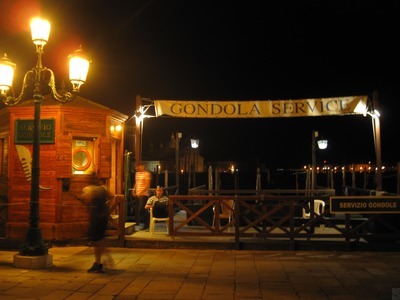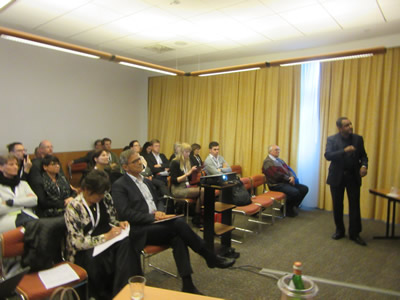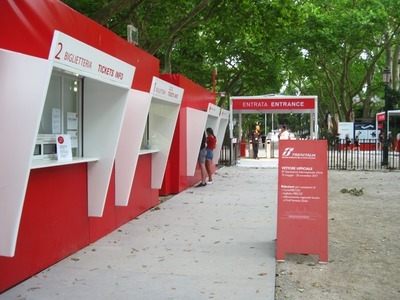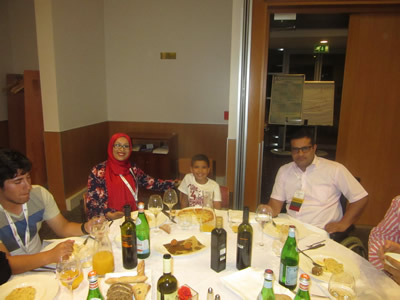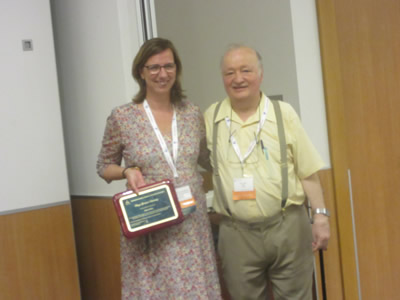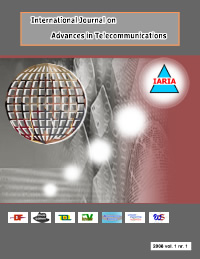ICWMC 2022 - The Eighteenth International Conference on Wireless and Mobile Communications
May 22, 2022 - May 26, 2022
ICWMC 2022: Call for Papers
Onsite and Online Options: In order to accommodate a large number of situations, we are offering the option for either physical presence or virtual participation (pdf slides or pre-recorded videos).
The International Conference on Wireless and Mobile Communications (ICWMC 2022) follows on the previous events on advanced wireless technologies, wireless networking, and wireless applications.
ICWMC 2022 addresses wireless related topics concerning integration of latest technological advances to realize mobile and ubiquitous service environments for advanced applications and services in wireless networks. Mobility and wireless, special services and lessons learnt from particular deployment complement the traditional wireless topics.
We welcome technical papers presenting research and practical results, position papers addressing the pros and cons of specific proposals, such as those being discussed in the standard fora or in industry consortia, survey papers addressing the key problems and solutions on any of topics, short papers on work in progress, workshops and panel proposals.
The topics suggested by the conference can be discussed in term of concepts, state of the art, standards, implementations, running experiments and applications. Authors are invited to submit complete unpublished papers, which are not under review in any other conference or journal in the following, but not limited to, topic areas.
We solicit both academic, research, and industrial contributions. We welcome technical papers presenting research and practical results, position papers addressing the pros and cons of specific proposals, such as those being discussed in the standard fora or in industry consortia, survey papers addressing the key problems and solutions on any of the above topics short papers on work in progress, and panel proposals.
Industrial presentations are not subject to the format and content constraints of regular submissions. We expect short and long presentations that express industrial position and status.
Tutorials on specific related topics and panels on challenging areas are encouraged.
The topics suggested by the conference can be discussed in term of concepts, state of the art, research, standards, implementations, running experiments, applications, and industrial case studies. Authors are invited to submit complete unpublished papers, which are not under review in any other conference or journal in the following, but not limited to, topic areas.
All topics and submission formats are open to both research and industry contributions.
ICWMC 2022 conference tracks:
Future in mobile systems
Mobility-centric world; Cooperative communications; Indoor and outdoor mobility; Extended satellite services; Mobile sensing and optimizations; Detection of mobile malware; Wearable-based of motion sensing and measurement; Wearable body-to-body networks; Emerging sensing methods; Automatic personal fitness assistance; Vehicular connectivity at crossroads; Cross-layer protocols for IoT traffic in 5G; Software Defined Networks (SDN)-based mobility management; Machine-to-machine (M2M) and Internet of Things (IoT); Mobile Cloud: WiFi signal-based human activity recognition; Dynamic spectrum access; Cognitive mobility; Wavefront multiplexing techniques; Edge computing in visual analytics; Cooperative content retrieval and distribution; Collaborative spectrum sensing; mm-Wave picocells; Reconfigurable Radio Frequency (RF) receivers; Traffic-aware of NFV (Network Function Virtualization); Energy harvesting; Large-scale array of dense distributed antennas; Advanced modulation schemes; 3GPP LTE enhancements and 5G; Resource Allocation in dense 5G deployments; Commodity devices; Physical vibration virtual keyboard; Tactile and haptic mobile Internet; Commodity WiFi devices; Macro-Femto interference avoidance; Mobile apps anomalies; GPS localization errors
Indoor & Outdoor Communication
Indoor and outdoor localization; Indoor and outdoor navigation; Road networks applications; Tracking; Walking directions; Mapping; Reference points; Sensing & Lighting; mmWave interference; Autonomous vehicles; Pedestrian localization; Industrial environments; Aerial vehicles; Non-RSS range-based systems; Time of Flight; Range modeling; Velocity estimation; Calibration & Auto-calibration; Uncertainty; Error mitigation; Observability
Mobility trends
SDN, SDX, NFV; 4G/5G and advanced mobile Internet; Internet of X (everything, things, people, etc.); Internet, Virtualization and Cloud; Big Data and mobile networks; Sensing and sensor networks; Energy-aware in mobile networks; Cellular cognitive networks; Future routing mechanisms; Mobility and wireless; Mobility enabling protocols; Mobile software; Service composition in mobile environments; Knowledge and service discovery in mobile environments; On-demand mobility; User presence in mobile environment
Slicing and 5/6/7G technologies
Network slicing models; 5G Network slicing Architecture; 5G/6G Networks slicing; End to End (E2E) network slicing; Automated networks slicing; Network Slice as a Service(NSaaS); Service slicing; IoT service slicing; Slicing-as-a-Service (SlaaS); Slicing and orchestration; Latency-sensitive 5G services; Differentiated slice-based 5G services; 5G E2E (End to End), 6G Cellular data networks; Indoor 5G Open Radio Access Network (O-RAN); 5G mmWave; 7G and 8G network and High speed internet. Network slicing market. Networks slicing ROI (Return on Investment); 6-7-8G and ROI.
Wireless Communications Basics
Coding & modulation & equalization; Channel modeling and characterization; Equalization/Synchronization; Transform-domain communication; Multiple access algorithms and schemes; Antenna and RF subsystems; Smart antennas, adaptive antennas, MIMO and beam forming; MIMO and OFDM Based PHY Layer technologies; CDMA Systems
Radio Interfaces and Systems
Radio communications systems; Radio resource management; Radio transmission technologies; Power and interference control; Interference Cancellation for Wireless Mobile Systems; Power management for small terminals; Energy map; Channel Measurement and Characterization
Spectrum Allocation and Management
Spectrum efficiency analyses; Dynamic spectrum access networks; Spectrum management; Interference mitigation and management techniques
Circuits for Wireless Communications
Wireless ASICs; Wireless technologies; RF Design issues
Wireless and Mobility
Mobility management; Location-based services and positioning; Micro and macro-mobility; Mobility, location and handoff management; Mobile and wireless IP; Wireless broadband mobile access; Routing in multihop, ad hoc and sensor networks; Wireless multicasting; Wireless mesh networks; Topology control in wireless
Protocols for wireless and mobility
Wireless protocols, architectural and design concepts; Protocols for air interfaces and networks; Wireless MAC protocols: Design and analysis; Transport layer issues in mobile and wireless networks; Middleware for handhelds and mobile services nodes; Proxies and middleware for wireless networks
Traffic and congestion control, QoS, Resource Management
Traffic Modeling and Analysis; 3G/4G Bandwidth on Demand; QoS and mobility; End-to-end QoS; QoS profiling and pricing; Traffic Engineering; Congestion and admission control
Wireless and mobile technologies
Micro-mobility and macro-mobility; Wireless LANs; Home and Personal Area Networks: Bluetooth, ZigBeee, etc; Wireless MANs:802.16, 802.20; Wireless WANs: 2G/3G/4G; Mobile ad hoc networks and multi-hop wireless; Sensor networks and applications; Ultra-wideband and short-range networks; High altitude platforms and satellites; Emergency wireless communications; Wireless real-time communications; RFID systems (including readers and transponders in LF, HF and UHF bands)
Performance Evaluation, Simulation and Modeling of wireless networks and systems
Performance and QoS in wireless networks; Radio channel modeling (wave propagation and measurements); Mobile/wireless networks modeling and simulation; Performance of end-to-end protocols over wireless networks
Management of wireless and mobile networks
Mobility and QoS management; Billing technologies and tools; Policy Based Management in wireless LANS and MANs; Wireless and Mobile Network Planning; Mobile Database Access and Design
Security in wireless and mobile environment
Security and robustness in wireless networks; Privacy, Authentication Authorization and Accounting (AAA); Encryption and Cryptography; Key Management Protocols; Digital Rights Management and Multimedia Protection
Networks convergence and integration
2G/3G/4G integration; Convergence of 3G wireless and Internet cross-layer design in wireless networks; WLAN/3G/4G integration; Wireless-wireline convergence; Heterogeneous Networks (WAN, Wireless MAN, WLAN); IP Multimedia subsystems (IMS); Next Generation Network Architecture- mobility issues; Coexistence of mobile radio networks; End to End QoS in Heterogeneous environment; Signaling for integrated wireline/wireless networks
Applications and services based on wireless infrastructures
Mobile & Wireless applications & services; Service discovery: protocols and frameworks; Personalized services and applications; Audio-visual and mobile multimedia applications; Media and content distribution over wireless networks
Standardization and regulations
Position on standards & fora on wireless and mobile networks; Wireless Networks Standards and Protocols; Communications regulations; 802.11 WLAN Standards; 802.16 WMAN Standards; 3GPP and 3GPP2 standards; HSDPA Technology and Standards; Next Generation Network standards
Design and implementation
Emerging wireless technologies; Cross-layer optimizations in wireless networks; Design and implementation of mobile information systems; Software defined radio and re-configurability; Joint PHY/MAC design
Wireless and mobile network deployment
Business models on wireless networks; Market trends and regional developments; M-commerce; Lessons learnt for wireless deployment in schools Lessons learnt for wireless deployment in special regions; Specialized wireless networks; Heterogeneous wireless network deployment (e.g., combining 802.11, 802.16 and 3G networks)
Cooperative and Cognitive Vehicular Networks
Architectures and platforms of cognitive vehicular network; Distributed artificial intelligence techniques for cognitive networks; Cognitive vehicular routing metrics and supporting protocols; Reduced complexity cognitive networks; Physical and MAC layer issues; Protocols design for cognitive vehicular networks; Cross-layer optimization in cognitive networks; Security issues for vehicular and cognitive networks; Testbed experiment, applications and new advances; Cooperative vehicular networks; QoS provisioning in heterogeneous networks ; Managing vertical handover; Multihoming; IPv6 GeoNetworking; Vehicular network architectures and protocols ; Cross-layer design and optimization for vehicular networks and cognitive networks; Mobility management and topology control; Standardization and Development of vehicular networks
Convergence and social mobility
Convergence of mobile networks with the Web 2.0; Convergence on architecture and services; Open service capabilities; Open exposure of telco capabilities; Open Web APIs, SOA and SDP); Interworking strategies; Mobile terminals as sources for User-generated content; Architecture and services for user-generated content; Auto-description and metadata synthesis for telecom-generated for user-generated content; Social mobile networks; User behavior profiling; Social connections (social graphs, contacts, etc); Services and architectures/solutions for social mobile services
Deadlines:
Submission | Feb 24, 2022 |
Notification | Mar 22, 2022 |
Registration | Apr 03, 2022 |
Camera ready | Apr 10, 2022 |
Deadlines differ for special tracks. Please consult the conference home page for special tracks Call for Papers (if any).
INSTRUCTION FOR THE AUTHORS
Authors of selected papers will be invited to submit extended versions to one of the IARIA Journals.
Publisher: XPS (Xpert Publishing Services)
Archived: ThinkMindTM Digital Library (free access)
Prints available at Curran Associates, Inc.
How to submit to appropriate indexes.
Only .pdf or .doc files will be accepted for paper submission. All received submissions will be acknowledged via an automated system.
Contribution types
- regular papers [in the proceedings, digital library]
- short papers (work in progress) [in the proceedings, digital library]
- ideas: two pages [in the proceedings, digital library]
- extended abstracts: two pages [in the proceedings, digital library]
- posters: two pages [in the proceedings, digital library]
- posters: slide only [slide-deck posted on www.iaria.org]
- presentations: slide only [slide-deck posted on www.iaria.org]
- demos: two pages [posted on www.iaria.org]
FORMATS
Only .pdf or .doc files will be accepted for paper submission. All received submissions will be acknowledged via an automated system.
Final author manuscripts will be 8.5" x 11", not exceeding 6 pages; max 4 extra pages allowed at additional cost.
Helpful information for paper formatting for MS Word can be found here.
There is a community provided LaTeX template: the CTAN package iaria (with full IARIA formatting rules, including IARIA citation style, but for providing citation style it is tightly bound to pdflatex+biblatex+biber). In addition, there is also iaria-lite (not bound to pdflatex+biblatex+biber, but compatible with any TeX stack; thus, it cannot provide the IARIA citation formattings, but only the titlepage and content-related IARIA formatting rules). Based on the iaria package, there is a minimal working example as Overleaf template. When you are using the LaTeX templates, please still adhere to the additional editorial rules.
Slides-based contributions can use the corporate/university format and style.
Your paper should also comply with the additional editorial rules.
Once you receive the notification of contribution acceptance, you will be provided by the publisher an online author kit with all the steps an author needs to follow to submit the final version. The author kits URL will be included in the letter of acceptance.
We would recommend that you should not use too many extra pages, even if you can afford the extra fees. No more than 2 contributions per event are recommended, as each contribution must be separately registered and paid for. At least one author of each accepted paper must register to ensure that the paper will be included in the conference proceedings and in the digital library, or posted on the www.iaria.org (for slide-based contributions).
CONTRIBUTION TYPE
Regular Papers (up to 6-10 page article -6 pages covered the by regular registration; max 4 extra pages allowed at additional cost- ) (oral presentation)
These contributions could be academic or industrial research, survey, white, implementation-oriented, architecture-oriented, white papers, etc. They will be included in the proceedings, posted in the free-access ThinkMind digital library and sent for indexing. Please submit the contributions following the instructions for the regular submissions using the "Submit a Paper" button and selecting the appropriate contribution type. 12-14 presentation slides are suggested.
Short papers (work in progress) (up to 4 pages long) (oral presentation)
Work-in-progress contributions are welcome. These contributions represent partial achievements of longer-term projects. They could be academic or industrial research, survey, white, implementation-oriented, architecture-oriented, white papers, etc. Please submit the contributions following the instructions for the regular submissions using the "Submit a Paper" button and selecting the contribution type as work in progress. Contributors must follow the conference deadlines, describing early research and novel skeleton ideas in the areas of the conference topics. The work will be published in the conference proceedings, posted in the free-access ThinkMind digital library and sent for indexing. For more details, see the Work in Progress explanation page. 12-14 presentation slides are suggested.
Ideas contributions (2 pages long) (oral presentation)
This category is dedicated to new ideas in their very early stage. Idea contributions are expression of yet to be developed approaches, with pros/cons, not yet consolidated. Ideas contributions are intended for a debate and audience feedback. Please submit the contributions following the instructions for the regular submissions using the "Submit a Paper" button and selecting the contribution type as Idea. Contributors must follow the conference deadlines, describing early research and novel skeleton ideas in the areas of the conference topics. The work will be published in the conference proceedings, posted in the free-access ThinkMind digital library and sent for indexing. For more details, see the Ideas explanation page. 12-14 presentation slides are suggested.
Extended abstracts (2 pages long) (oral presentation)
Extended abstracts summarize a long potential publication with noticeable results. It is intended for sharing yet to be written, or further on intended for a journal publication. Please submit the contributions following the instructions for the regular submissions using the "Submit a Paper" button and selecting the contribution type as Extended abstract. Contributors must follow the conference deadlines, describing early research and novel skeleton ideas in the areas of the conference topics. The work will be published in the conference proceedings, posted in the free-access ThinkMind digital library and sent for indexing. 12-14 presentation slides are suggested.
Posters (paper-based, two pages long) (oral presentation)
Posters are intended for ongoing research projects, concrete realizations, or industrial applications/projects presentations. The poster may be presented during sessions reserved for posters, or mixed with presentation of articles of similar topic. A two-page paper summarizes a presentation intended to be a POSTER. This allows an author to summarize a series of results and expose them via a big number of figures, graphics and tables. Please submit the contributions following the instructions for the regular submissions using the "Submit a Paper" button and selecting the contribution type as Poster Two Pages. Contributors must follow the conference deadlines, describing early research and novel skeleton ideas in the areas of the conference topics. The work will be published in the conference proceedings, posted in the free-access ThinkMind digital library and sent for indexing. 8-10 presentation slides are suggested. Also a big Poster is suitable, used for live discussions with the attendees, in addition to the oral presentation.
Posters (slide-based, only) (oral presentation)
Posters are intended for ongoing research projects, concrete realizations, or industrial applications/projects presentations. The poster may be presented during sessions reserved for posters, or mixed with presentation of articles of similar topic. The slides must have comprehensive comments. This type of contribution only requires a 8-10 slide-deck. Please submit the contributions following the instructions for the regular submissions using the "Submit a Paper" button and selecting the contribution type as Poster (slide-only). The slide-deck will be posted, post-event, on www.iaria.org.
8-10 presentation slides are suggested. Also a big Poster is suitable, used for live discussions with the attendees, additionally to the oral presentation.
Presentations (slide-based, only) (oral presentation)
These contributions represent technical marketing/industrial/business/positioning presentations. This type of contribution only requires a 12-14 slide-deck. Please submit the contributions following the submission instructions by using the "Submit a Paper" button and selecting the contribution type as Presentation (slide-only). The slide-deck will be posted, post-event, on www.iaria.org.
12-14 presentation slides are suggested.
Demos (two pages) [posted on www.iaria.org]
Demos represent special contributions where a tool, an implementation of an application, or a freshly implemented system is presented in its alfa/beta version. It might also be intended for thsoe new application to gather the attendee opinion. A two-page summary for a demo is intended to be. It would be scheduled in special time spots, to ensure a maximum attendance from the participants. Please submit the contributions following the submission instructions by using the "Submit a Paper" button and selecting the contribution type as Demos. The Demos paper will be posted, post-event, on www.iaria.org.
Tutorial proposals
Tutorials provide overviews of current high interest topics. Proposals should be for 2-3 hour long. Proposals must contain the title, the summary of the content, and the biography of the presenter(s). The tutorial slide decks will be posted on the IARIA site.
Please send your proposals to tutorial proposal
Panel proposals
The organizers encourage scientists and industry leaders to organize dedicated panels dealing with controversial and challenging topics and paradigms. Panel moderators are asked to identify their guests and manage that their appropriate talk supports timely reach our deadlines. Moderators must specifically submit an official proposal, indicating their background, panelist names, their affiliation, the topic of the panel, as well as short biographies. The panel slide deck will be posted on the IARIA site.
Please send your proposals to panel proposal






